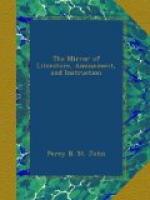“Our readers will remember the beautiful parable of the good Samaritan, and his kindness and compassion for the wounded stranger ‘who fell among thieves,’ on his journey from Jerusalem to Jericho. Sichem or Sychar, the district of the Samaritans, and which they now inhabit, is about forty miles from Jerusalem. Jericho is about nineteen miles from the capital of Judea; and, as it was in the first century, so the intervening country still remains infested by banditti. Sir Frederick Henniker, as late as 1820, on his journey from Jerusalem to Jericho, was way-laid, attacked by a band of predatory Arabs, and plundered. He was stripped naked, and left severely wounded; and in this state was carried to Jericho.”
David and Goliath.
“David’s encounter with Goliath, the champion of the Philistines, is mentioned in I Samuel xvii.: and in the 40th verse is described the simple armour with which the shepherd boy, Jesse’s son, repaired to the contest. Many a thirsty pilgrim, as he passes through the valley of Eluh, on the road from Bethlehem to Jaffa (Joppa), has drunk of ’the brook in the way’—that very brook from whence the minstrel youth ’chose him five smooth stones.’ ‘Its present appearance,’ says a recent traveller, ’answers exactly to the description given in Scripture; the two hills on which the armies stood, entirely confined it on the right and left. The valley is not above half a mile broad. Tradition was not required to identify this spot. Nature has stamped it with everlasting features of truth. The brook still flows through it in a winding course, from which David took the smooth stones.’”
The Willows of Babylon.
“In reference to the willow and the streams of Babylon, where the Hebrews remembered Zion so mournfully, Sir Robert Ker Porter states, that ’the banks of the Euphrates were hoary with reeds, and the grey osier willows were yet there on which the captives of Israel hung their harps,’ and wept in the land of the stranger. The salix babylonica, or the weeping willow, in its geographical range, sweeps through the plains of Judea, and by the ruins of Babylon, from the verge of the Mediterranean to the frontiers of Japan—a lovely line of beauty—the Niobe of vegetation! Sad memorial of the mournful march of the captive Hebrews. It is, we think, a very striking circumstance, that these countries should even now retain such unchanged lineaments of their ancient history. Time seems to linger, or move slowly on; as if the wheels of nature stood still, and paused at the mournful sight of departed grandeur and buried magnificence—BABYLON in ruins! ’MENE!—GOD hath numbered thy kingdom, and finished it!’ Mr. Rich has given us a sketch of a spade copied from a Babylonian brick found near El Kasr, and detached from a mass of ruin, in all probability, on the very site of Nebuchadnezzar’s pensile gardens; and he remarks, that it is almost a fac simile of the spade used at this very day in Chaldea.”




